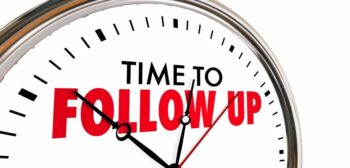In a world where many businesses focus solely on attracting new customers and clients, maintaining strong relationships with the ones you already have can give you a significant edge. Following up after an interaction, whether it’s a sale, a service, or a meeting, shows that you value the relationship beyond the transaction. Consistent follow-ups can improve satisfaction, build loyalty, and even generate referrals. Here’s why this strategy matters and how you can make it a seamless part of your routine.
Why Follow-Ups Matter
- It Shows You Care
A thoughtful follow-up demonstrates that you’re genuinely interested in the well-being and success of your customers and clients. It tells them they’re more than just another name on your list—they’re valued partners in a relationship. - It Builds Trust and Loyalty
Consistency in communication fosters trust. When you proactively reach out, you show reliability and a willingness to go the extra mile, which strengthens client loyalty. Over time, these small gestures can make a big difference in retaining business. - It Provides Opportunities to Address Concerns
Sometimes, customers or clients may not voice concerns right away. A follow-up gives them a chance to share feedback, helping you address any issues before they escalate. This not only improves their experience but also helps you refine your services. - It Keeps You Top of Mind
Staying in touch ensures your customers and clients remember you when they need your services again—or when someone asks for a referral. A quick follow-up email or call can remind them of the value you provide. - It Strengthens Your Reputation
Word-of-mouth referrals and positive reviews often come from customers and clients who feel genuinely cared for. By following up, you create opportunities for them to sing your praises to others.
How to Master the Art of the Follow-Up
- Time It Right
The timing of your follow-up can make a big difference. After an initial interaction, aim to follow up within 24-48 hours to show you’re attentive. For ongoing relationships, schedule periodic check-ins based on the client’s needs and preferences. - Personalize Your Communication
Generic messages won’t cut it. Mention specific details from your previous conversation, such as the product they purchased, the service they received, or the goals they discussed. Personalization shows that you’re paying attention. - Use the Right Channels
Consider how your customers and clients prefer to communicate. Some may appreciate a quick email, while others might prefer a phone call or even a handwritten note. Tailoring your approach makes the follow-up feel more meaningful. - Provide Value in Each Follow-Up
Every interaction should offer something useful. This could be an update on their project, a relevant resource, or a reminder about an upcoming deadline. Value-driven follow-ups reinforce your role as a helpful partner. - Automate Without Losing the Personal Touch
Tools like CRM systems and email automation can help you stay on top of follow-ups without overwhelming your schedule. Just make sure to add a personal touch, such as addressing the recipient by name or referencing their specific needs. - Track Your Interactions
Keep detailed records of your communications. This not only ensures you don’t miss a follow-up but also helps you tailor your future interactions based on past conversations. - Close the Loop
If your follow-up is tied to a specific issue or request, make sure to close the loop by confirming that the matter has been resolved to their satisfaction. This reinforces your commitment to excellent service.
Examples of Follow-Up Scenarios
- After a Sale: Thank them for their purchase, confirm they’re satisfied with the product or service, and offer assistance if needed.
- After a Meeting: Summarize key points discussed, provide any promised materials, and outline next steps.
- After Resolving an Issue: Check in to ensure the solution met their expectations and invite additional feedback.
- Periodic Check-Ins: Send updates on new products, services, or industry trends that might interest them.
Make Follow-Ups Your Competitive Advantage
Following up doesn’t have to be time-consuming or complicated, but it does require intentionality. When done right, it becomes a powerful tool for strengthening relationships, addressing concerns, and building loyalty.
By making follow-ups a consistent part of your routine, you’ll set yourself—and your organization—apart. Customers and clients will notice the extra effort, and that effort will translate into trust, satisfaction, and long-term success.
